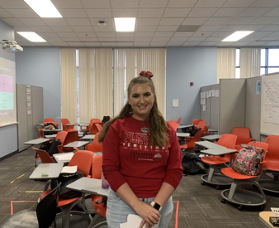Chamber News
DEIA | Metro Early College Middle School Prepares Students for the Future
December 15th, 2022
Children comprise 22% of the U.S. population and ALL of our future.

Supply chain issues became apparent during the COVID-19 pandemic and we’re still experiencing those challenges today. That’s why Mary Barton, the 6th Grade Social Studies teacher at Metro Schools, encouraged her students to formulate solutions to common supply chain issues and showcase their work via presentations. Metro Schools is known for its diverse student population, high proficiency rate, and high graduation rate. The teachers and administrative lead the schools using inclusive and equitable principles and practices. Students leave Metro prepared for college, the workforce, or business ownership.
To start their work, students formed teams and researched issues such as:
- How conflicts between countries affect the supply chain
- Root causes of the truck driver, dock worker, and warehouse worker talent shortage
- How to resolve the microchip, medicine, and/or weapons shortage
Once they did the research, they worked together to explore solutions and develop presentations to share their work. I, along with two employees from Ascension Construction Solutions, served as judges. As a former Transformation leader, I was excited to be surrounded by creativity and innovation.
Here are a few examples that illustrate the student’s ingenuity and talent.
- Build medicine manufacturing facilities closer to pharmacies to reduce travel time and costs
- Develop your own talent pool and go where the untapped talent is; don’t expect them to come to you
- Create a culture that makes people want to show up and do their best every day
- Offer benefits that people actually need and use
- Develop a solid attraction strategy and campaign and shorten the time from interview to hire
- Create websites, podcasts, or YouTube channels to bring awareness to the issues and brainstorm solutions with visitors and listeners
- Use planes instead of boats to transport weapons
- Use a blimp that houses drop-ship drones for deliveries
- Build and use robots for tasks that people no longer want to do
These are just a few of the creative solutions. In addition, students suggested strategies to fund their solutions.
A team of students designed a microchip factory (with workers and equipment) using Legos. Other teams drew their concepts in intricate detail. One team produced a podcast that could rival any podcast on Apple or Spotify. We had the pleasure of exploring the websites the students developed and I must say, we were impressed. I wanted to hire them all.
What did I learn from Mrs. Barton and her students? When you develop young minds and challenge them to solve real-world problems, you get results. Also, while we should continue to develop the K-12 pipeline to be future workers, entrepreneurs, and venture capitalists, we don’t have to wait until students come of age to engage them in finding solutions to the world’s problems.
I challenge each of you to get involved with your local school district to help shape our emerging talent. If you need some guidance on how to get started, reach out to our friends at Ascension Construction Solutions. They continue to impress me with their level of involvement in the K-12 pipeline.
Children are the solution to the world’s problems and teachers like Mrs. Barton help them be their best each day.

Sherrice Thomas
Vice President of Diversity, Equity, Inclusion & Access
SherriceThomas@columbus.org

